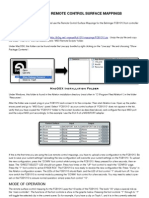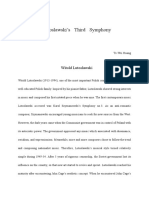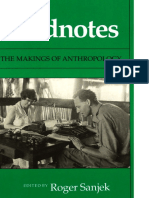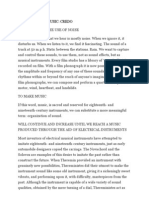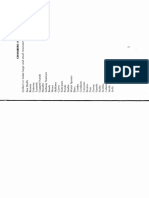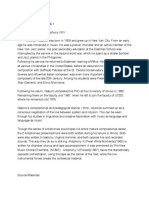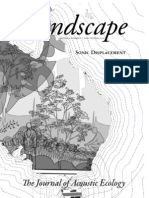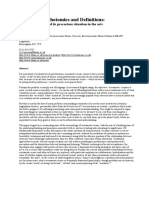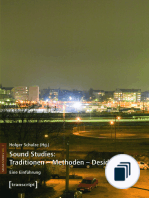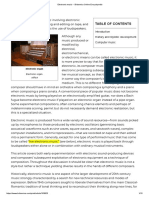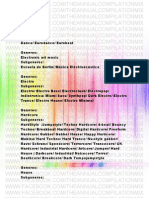Mind in Art PDF
Mind in Art PDF
Uploaded by
Hélène ElstCopyright:
Available Formats
Mind in Art PDF
Mind in Art PDF
Uploaded by
Hélène ElstOriginal Title
Copyright
Available Formats
Share this document
Did you find this document useful?
Is this content inappropriate?
Copyright:
Available Formats
Mind in Art PDF
Mind in Art PDF
Uploaded by
Hélène ElstCopyright:
Available Formats
Mind in Art
Author(s): Jji Yuasa
Source: Perspectives of New Music, Vol. 31, No. 2 (Summer, 1993), pp. 178-185
Published by: Perspectives of New Music
Stable URL: http://www.jstor.org/stable/833382
Accessed: 13-08-2015 12:18 UTC
Your use of the JSTOR archive indicates your acceptance of the Terms & Conditions of Use, available at http://www.jstor.org/page/
info/about/policies/terms.jsp
JSTOR is a not-for-profit service that helps scholars, researchers, and students discover, use, and build upon a wide range of content
in a trusted digital archive. We use information technology and tools to increase productivity and facilitate new forms of scholarship.
For more information about JSTOR, please contact support@jstor.org.
Perspectives of New Music is collaborating with JSTOR to digitize, preserve and extend access to Perspectives of New Music.
http://www.jstor.org
This content downloaded from 193.191.187.200 on Thu, 13 Aug 2015 12:18:12 UTC
All use subject to JSTOR Terms and Conditions
MIND IN ART1
JOJIYUASA
1. ARTWORK
AND PHYSICAL
FACT
WE USUALLYDO NOT have problems with expressions such as "I saw a
wonderful picture" or "I listened to some impressive music." However,
further consideration leads us to wonder what signifies that which we
usually call "picture" or "music."
A sunflower by Van Gogh or an apple by Cezanne, for instance, seem
to exist with both voluminous and textural qualities in space. However,
the space is actually only a two-dimensional plane and it consists of canvas and pigment. When we talk about a "sorrowful music," what is meant
by sorrowful? If music is composed of acoustical, sonic combinations, are
sounds as such really "sorrowful"?
It turns out that acoustical sounds are not "sorrowful," but that the
music has something which evokes sorrow within a listener. Therefore,
This content downloaded from 193.191.187.200 on Thu, 13 Aug 2015 12:18:12 UTC
All use subject to JSTOR Terms and Conditions
A Jostled Silence (3)
179
the expression, "the music is sorrowful," can be included in a judgment
by a listener, and it does not mean that the acoustical organization (i.e.,
the music itself) has such properties. As for sunflowers, the art of Van
Gogh does not consist of physical objects consisting of canvas and pigment, but the illusion of a sunflower evoked in a viewer.
What is perceived in a picture is not a layer of pigment on canvas. What
is perceived in music is not sounds but an illusion emerging from the
transformation of movements through time and space. A phrase by B.
Croce, "True artwork is spiritual and imaginative; it is not a physical
fact," seems to suggest that art does not only remain at a perceptual level
but enters deeply into our minds.
If one could differentiate between "brain" and "mind," I think that
the brain is a sort of control center in which digital and analog inputs are
intensively processed. When "mind" is men...
mind"vefers
tioned, it refers to a function of the brain, a
floating state in which so-called spiritual functo afunction
the brain,
-1of
11
floatingT~~~~~~
tions are at work. I would like
to talk about what
aoating
state
afloatingfstate
the structure of this mind is for artists like
in which
myself.
spiritualfunctions
are at work.
Needless to say, the definition or the concept
behind art is not fixed, but changes as time
passes. Moreover, there is some confusion as to the activities within art.
Roughly speaking, there are three areas within art: creative activities, the
work itself, and the receiving (interpreting) of the work.
It is appropriatenow to discuss the situation of artists who are involved
in creative activities, and this will relate to the art work itself as well as to
its interpretation.
2. CIRCUMSTANCES
First of all, we have to consider the general circumstances. They guide
the imaginations of artists:geographic or climatic features of the environment and history, which for the Japanese have to do with traditional
roots. These are the issues which are relevant to
a No dancer
a recognition of time and space; in other words,
a
of
the
movesas if
world.
they comprise FtheyM~
way understanding
~he
wishes
compriser~
way~
There are as many
differences in the way a~
the
to bunfied
mind structures thought as there are languages
with theground.
(Japanese, French, American, etc.).
We can clearly see the differences in mentality influenced by circumstances in the following examples: Chinese paintings, which imply various
meanings within large empty spaces, and paintings by Van Gogh, which
This content downloaded from 193.191.187.200 on Thu, 13 Aug 2015 12:18:12 UTC
All use subject to JSTOR Terms and Conditions
180
Perspectives
of NewMusic
explore the sensation of volume through the brushing of pigment onto
the canvas;ballet, in which a dancer attempts to lightly fly as high as possible, resisting gravity, and N6, in which a dancer moves (keeping his feet
on the floor) as if he wishes to be unified with the ground; Western
music, which tries to arrive at a wholeness of harmony while various
voices individually keep linear and stable behaviors, and the sounds of the
Japanese shakuhachior koto, which move in curves, seeking the subtlest
inflections and transitions of timbre.
On the other hand, we should also mention those mental activities
which actively or subjectively select or reflect the particular influences
which one may receive. For instance, Taro Okamoto, a visual artist, sees
the origin of Japanese sensibilities in the open spirit of vitalistic life during the Jomon period, while I rather see the model for Japanese ideas in
Zeami's N6 and the vitality of the Muromachi and Kamakura periods,
where Buddhist monks such as Dogen, Honen, and Shinran preached
sermons. This issue varies depending upon the artist's subjective choices;
some may experience it in Gagaku, while others may discover it through
the writings of Chikamatsu or Tsuruya Namboku of the Edo period.
3. TIME AND SPACE IN MUSIC AND MIND
It is often said that classicalmusic consists of three elements: melody, harmony, and rhythm. The sounds involved are so-called "musical sounds"
and possess periodic wave forms. If we consider the fact that European
music is not the sole music of the world, the former idea about music
turns out to refer specifically to Western music. The shakuhachi, for
instance, does not produce any harmony; noises, including white noise,
make up a large part of its resource. Therefore, I think in order to
include all the musics outside of Europe as well as contemporary music, it
would be more appropriate to consider music as a transformation of
sound energy (formal transformation) along a temporal axis.
It is clear that musical works have temporal structures; they also
involve spatial elements (distances) because they are structured. In other
words, music attributes its nature to an association of ideas which occur
essentially as temporal phenomena; at the same time, it contains this
notion of spatiality.For instance, a pitch relationship determines a space
which is vertically manifest and a duration determines a space which is
horizontally manifest. The light and shade of timbre, density, and illusory
localization can also be spatiallyperceived.
Since each individual moment of the melody, harmony, or dynamic is
related to the syntax (the structural principles behind the writing), music
possesses not only a currently ongoing time, but also another imaginative
This content downloaded from 193.191.187.200 on Thu, 13 Aug 2015 12:18:12 UTC
All use subject to JSTOR Terms and Conditions
181
A Jostled Silence (3)
time which constitutes an aggregate of various elements and is a function
which the listener must bring forth. These notions of time are abstracted
onto a spatial axis.
ls
Z
RL hI)
(;p
qwt
co
s|
-'--
This can certainly be called a "mental operation"; one converts the
temporal organization into a spatial diagram. One of the reasons that animals do not exhibit any art-like behavior may be found in their lack of
the ability to convert time into space and analog to digital (i.e., figures
into numbers).
As we already know, the fact that man has acquired language is one of
his characteristicidentities. The ability to make signs, as well as to convert the temporal to a spatial diagram, might have differentiated the
human being, for instance, from the apes. As mentioned in the beginning, this particular function is related to art as a mental operation; art
cannot exist without it.
4. PHENOMENON AND SYMBOLIZATION
Music needs to be read in order to be performed. Sonic events are symbolized and notated for performance. It is well known that musical notes
are symbolic signs which designate pitches and durations in the conventional notation system. However, further consideration shows that there
are two distinct kinds of notation systems: quantitative notation and
qualitative notation.
With quantitative notation, the length of a duration is fixed as with the
quarter note or eighth note of conventional notation. The specific
This content downloaded from 193.191.187.200 on Thu, 13 Aug 2015 12:18:12 UTC
All use subject to JSTOR Terms and Conditions
182
Perspectivesof New Music
duration of the quarter note is quantitatively determined, for instance, to
be sixty-four per minute.
With qualitative notation, on the other hand, the manner in which
sounds are to be generated and the characteristicsof performance (such
as pizzicato, scrubbing motions, and sound-producing gestures) are
notated by graphic notation (see Example 1). Such notational systems are
widely used in contemporary music, but the same qualitative features are
found in goma-ten, in yokyoku,and kuchishoga,and in the vocal rendition
of instrumental expressions used in koto and shamisen music (such as
sararin and chin ton shan).
5. THE RELATIONSHIP OF ARTISTIC THOUGHT TO SCIENCE
As previously mentioned, art is transformed as time passes. If we view the
history of art in periods (Classical, Romantic, Impressionist, and Contemporary), we understand that they are rooted in a "common sensibility," and can be seen in artists living within the same period (Goethe and
Beethoven; E.T.A. Hoffmann and Schumann; Delacroix, George Sand,
and Chopin; and Mallarme and Debussy).
It is not too exaggerated to say that almost all scientific thought and
disciplines (mathematics, physics, and medical science, for example) cast
their "shadows" onto art. Art certainly invites its recipients to a wonderland which goes far beyond daily life, but at the
Art invites
same time appears as a total reflection of man's
its recients tocosmology.
Our civilization has entered the
a wonderland
electronic
If man's life-style is changed
age.
whichgoesfar
advances
in science, man's manner of
through
beyond
thought, perception and sensibility will be
dailylife.
altered as well.
For instance, we can have a real-time pseudo-experience of the events
occurring on the other side of the earth through television, a "small window to peep out at the world." If one is on a jet liner, he can gaze upon
the earth from a bird's-eye perspective, and see a planet that people in
previous ages never could. We can now even experience Mach speeds.
Such new experiences, without any doubt, have forced revolutionary
changes in the sensibilities of man, who just two hundred years ago traveled only at the speed of a running horse. We can recognize this change
in our sensibility if we compare the sensation one might have when
climbing to a height of three hundred meters to the pseudo-somatic
imaginary feeling one would have ascending this same height over the
This content downloaded from 193.191.187.200 on Thu, 13 Aug 2015 12:18:12 UTC
All use subject to JSTOR Terms and Conditions
A Jostled Silence (3)
183
O Mass tone; however, one tone is considered to be the minimum. The
performer may choose to play a chord of any number of tones (one or
more).
- Pizzicato with sustaining pedal down.
*Mute strings with finger near the bridge.
Mute with sustaining pedal.
Mute the string just after attacking the note from the keyboard; the
tone is not restruck.
O Strike the string with a vibraphone mallet.
A
Step hard on the sustaining pedal.
Time is proportional to space left to right along the horizontal axis, and pitch
(high to low) is relative to the vertical axis.
The dynamics are left to the discretion of the performer.
The use of the pedal is free, unless otherwise indicated.
Oblique lines indicate phrasing.
Graphs, composed of many oblique lines, indicate a circuit. In the circuit, the
performer must proceed along the oblique lines from left to right without
retracing his path until no farther motion left to right is possible. He may then
return to the beginning and proceed left to right again. A performer may follow any path, and he may repeat the circuit as many times as he wishes.
EXAMPLE 1: (FROM PROJECTION ESEMPLASTIC FOR PIANO(S)
BY JOJI YUASA, 1961)
This content downloaded from 193.191.187.200 on Thu, 13 Aug 2015 12:18:12 UTC
All use subject to JSTOR Terms and Conditions
184
Perspectivesof New Music
Kasumisaseki Building's sixty floors in twenty seconds using an express
elevator.
i
---F1
c,
l
1
ce----
l
r
--
c
X
X-------1
Similar to Marshall McLuhan's concept of the mechanical extensions
of man, his sensibilities also extend in a parallel sense. Contemporary
plastic arts, including film, make constant use of electronics, computers,
video techniques, and all kinds of new materials;while in music, one finds
effective uses of electronic technology such as tape and computers. These
extensions do not apply only to practical matters, but also to habits of
thought, for instance, to mathematical procedures such as topology,
probability, and stochastics, all of which have greatly influenced procedures in art.
As the frontiers of science approach issues such as chaos (a kind of irrational landscape), art also attempts to approach such an irrational world
with a scientific personality. Westerners never turned their eyes to the
East as eagerly as they do now. Art now tries to address, for instance, the
problem of irrationality,in such a seemingly contradictory term as "controlling indeterminacy."
John Cage, the American composer, was an ardent admirer of Daisetsu
Suzuki, and was trained in Zen Buddhism more than is the ordinary Japanese. European contemporary music was significantly changed by Cage.
Such influence is discovered in the "open form" music, which refers to
forms that are not fixed; there was also an acceptance of what is known in
Zen as "as-it-is-ness." It is the effort not to place events in a musically
fixed form, but to grasp them as a fluid whole. Such a form appearsin the
music of chance operations and the music of indeterminacy, which have a
close relationship to the graphic notation mentioned above.
A counterpart in the field of plastic arts would be the mobiles of Alexander Calder, which Jean-Paul Sartre described as "sensitive symbol[s] of
the nature and original feeling of life."
These examples are only a few of the obvious trends in the current art
situation. As mentioned before, since art is in a sense a metonymy of the
This content downloaded from 193.191.187.200 on Thu, 13 Aug 2015 12:18:12 UTC
All use subject to JSTOR Terms and Conditions
A Jostled Silence (3)
185
totality of man's activity, the art which man creates and produces as his
legacy cannot cling to the styles of the past, but evidently needs to
explore the new worlds with new materials
art is in a sense
which man has acquired.
In the present situation, the computer is not,
tha
f
totity
ofthe totality
in fact, autonomously creative, although it is
of man'sactivity.
analytical and representational. That does not
mean, however, that the creation of plastic arts and music with computers is not in itself creative. Because it is the artist who writes the computer
program, there is no essential difference between art using computers
and art which does not use computers.
In the creation of music, a composer realizing an image creates a procedure, which is, in fact, already a kind of programming. The actual procedure may be executed by a computer as a substitute for hands or for a
part of the brain's function. According to the principle with which man
creates an "extension" of himself, a tool becomes an extension of the
hands, a musical instrument becomes an extension of the vocal chords,
and a car becomes an extension of the feet. In this sense, it is appropriate
to think that in art, the realization of an image by a computer is executed
as a substitute for or as an extension of the brain.
Previously, many criticized electronic music and tape music, which are
both created from the material of natural or electronically generated
sounds, as being "inhuman" because there was no act of performance by
a human being. The statement by Croce that "physical fact is not an
artistic truth," would be appropriatein this context. No matter how art is
processed by technological manipulation, what is fundamental to it is
man's imagination; there is no art without the operation of spiritualfunctions. Art is brought into existence because there is "mind."
This content downloaded from 193.191.187.200 on Thu, 13 Aug 2015 12:18:12 UTC
All use subject to JSTOR Terms and Conditions
You might also like
- Daft-Punk-Get-Lucky (Lead Sheet) PDFDocument2 pagesDaft-Punk-Get-Lucky (Lead Sheet) PDFlhuyen3593% (14)
- You Spin Me Right RoundDocument6 pagesYou Spin Me Right RoundivanovivanNo ratings yet
- Groove in Trip Hop MusicDocument9 pagesGroove in Trip Hop Musicapi-266099304100% (1)
- Kits Beach Hildegard Westerkamp TranscriptDocument4 pagesKits Beach Hildegard Westerkamp TranscriptOscar Giuseppe RíosNo ratings yet
- Kontakte by Karlheinz Stockhausen in Four Channels: Temporary Analysis NotesDocument16 pagesKontakte by Karlheinz Stockhausen in Four Channels: Temporary Analysis NotesAkaratcht DangNo ratings yet
- Fauna ManualDocument9 pagesFauna ManualAntonio CapogrossoNo ratings yet
- CF ANTHOLOGY1819 Update57 PDFDocument64 pagesCF ANTHOLOGY1819 Update57 PDFErnesto FreieNo ratings yet
- CUT AND PASTE: COLLAGE AND THE ART OF SOUND - Kevin ConcannonDocument26 pagesCUT AND PASTE: COLLAGE AND THE ART OF SOUND - Kevin ConcannonYotam KadoshNo ratings yet
- OCTOGRIS Manual en 64bitsDocument31 pagesOCTOGRIS Manual en 64bitsAnonymous anQLg1aNo ratings yet
- Installation: Ableton Live Fcb1010 Remote Control Surface MappingsDocument3 pagesInstallation: Ableton Live Fcb1010 Remote Control Surface MappingspablosalacoNo ratings yet
- Kompositionen für hörbaren Raum / Compositions for Audible Space: Die frühe elektroakustische Musik und ihre Kontexte / The Early Electroacoustic Music and its ContextsFrom EverandKompositionen für hörbaren Raum / Compositions for Audible Space: Die frühe elektroakustische Musik und ihre Kontexte / The Early Electroacoustic Music and its ContextsNo ratings yet
- The Aesthetics of Noise SangildDocument11 pagesThe Aesthetics of Noise SangildPino AlessandriNo ratings yet
- Living Mice - Minecraft Piano CoverDocument2 pagesLiving Mice - Minecraft Piano CoverZak SinghNo ratings yet
- Lutoslawski EssayDocument10 pagesLutoslawski EssayTe Wei HuangNo ratings yet
- CLIFFORD James Notes On Field Notes PDFDocument33 pagesCLIFFORD James Notes On Field Notes PDFAndra ZambranoNo ratings yet
- Luigi NonoDocument3 pagesLuigi NonomikhailaahteeNo ratings yet
- Perspectives of New Music Perspectives of New MusicDocument36 pagesPerspectives of New Music Perspectives of New MusicIgg100% (1)
- Murail. The Revolution of Complex SoundsDocument16 pagesMurail. The Revolution of Complex SoundsЯна Романчук100% (1)
- Future of MusicDocument4 pagesFuture of MusicFrancisco EmeNo ratings yet
- Alvin Lucier - ChambersDocument7 pagesAlvin Lucier - ChambersAmarillo VejigaNo ratings yet
- 17 Babitt Boulez&StockhausenDocument11 pages17 Babitt Boulez&StockhausenEric SnyderNo ratings yet
- Burrows InstrumentalitiesDocument10 pagesBurrows InstrumentalitiesStephenDedalusNo ratings yet
- L'objet SonoreDocument10 pagesL'objet SonoreipiresNo ratings yet
- Subtractive Synthesis: Terms & Abbreviations UsedDocument5 pagesSubtractive Synthesis: Terms & Abbreviations UsedCarlos del Río SilvánNo ratings yet
- 20th Century Form by James Tenney PDFDocument21 pages20th Century Form by James Tenney PDFPaul ChauncyNo ratings yet
- Kenneth GaburoDocument2 pagesKenneth GaburoAlexander KlassenNo ratings yet
- Wave Shaping SynthesisDocument12 pagesWave Shaping SynthesisVadim Drokov100% (1)
- Sound Gesture and Symbol PDFDocument22 pagesSound Gesture and Symbol PDFRafael Lima PimentaNo ratings yet
- Tarantella Del '600 (YouTube Version) TAB PDFDocument3 pagesTarantella Del '600 (YouTube Version) TAB PDFMahavishnu ToolfrippNo ratings yet
- Scape 14Document40 pagesScape 14antonello_colimbertiNo ratings yet
- English CadenceDocument3 pagesEnglish CadenceCarlos Gutiérrez100% (1)
- M Logos I0002 A0018 02 PDFDocument19 pagesM Logos I0002 A0018 02 PDF2413pagNo ratings yet
- Roman Haubenstock RamatiDocument2 pagesRoman Haubenstock RamatiMehrdad GhaffariNo ratings yet
- Intervista Max MethewsDocument14 pagesIntervista Max MethewsRoberto PalazzoloNo ratings yet
- Gottfried Michael Koenig Aesthetic Integration of Computer-Composed ScoresDocument7 pagesGottfried Michael Koenig Aesthetic Integration of Computer-Composed ScoresChristophe Robert100% (1)
- Dilemmas, Dichotomies and Definitions:: Acousmatic Music and Its Precarious Situation in The ArtsDocument13 pagesDilemmas, Dichotomies and Definitions:: Acousmatic Music and Its Precarious Situation in The ArtsMatthias StrassmüllerNo ratings yet
- Pierre Boulez and Andrew Gerzso - Computers in MusicDocument8 pagesPierre Boulez and Andrew Gerzso - Computers in MusicJorge A. Avilés100% (1)
- Robert Hasegawa Ge Rard Grisey and The Nature of HarmonyDocument23 pagesRobert Hasegawa Ge Rard Grisey and The Nature of Harmonymorgendorffer100% (1)
- Approaches To Using Rules As A Composition MethodDocument18 pagesApproaches To Using Rules As A Composition MethodLu YinNo ratings yet
- Max at SeventeenDocument18 pagesMax at Seventeenaliloia1No ratings yet
- The Road To Plunderphonia - Chris Cutler PDFDocument11 pagesThe Road To Plunderphonia - Chris Cutler PDFLeonardo Luigi PerottoNo ratings yet
- WISHART Trevor - Extended Vocal TechniqueDocument3 pagesWISHART Trevor - Extended Vocal TechniqueCarol Moraes100% (1)
- Multi-Channel Formats in Electroacoustic Composition: Acoustic Space As A Carrier of Musical StructureDocument4 pagesMulti-Channel Formats in Electroacoustic Composition: Acoustic Space As A Carrier of Musical StructureNikos StavropoulosNo ratings yet
- Irin Micromontage in Graphical Sound Editing and Mixing Tool PDFDocument4 pagesIrin Micromontage in Graphical Sound Editing and Mixing Tool PDFAnonymous AqIXCfp100% (1)
- Fractals and MusicDocument9 pagesFractals and MusicMelanie AllenNo ratings yet
- Music and Spatial VerisimilitudeDocument210 pagesMusic and Spatial VerisimilitudeAlan Ahued100% (1)
- Intoroduction To Luening and Ussachevskys Incantation PDFDocument6 pagesIntoroduction To Luening and Ussachevskys Incantation PDFXavier Falques100% (1)
- La Fonction Compositionnelle Des Modulateurs en Anneau Dans: MantraDocument6 pagesLa Fonction Compositionnelle Des Modulateurs en Anneau Dans: MantracmescogenNo ratings yet
- Concerning SprechgesangDocument5 pagesConcerning SprechgesangZacharias Tarpagkos100% (1)
- Mdegranular : Granular Synthesis External For Max:mspDocument7 pagesMdegranular : Granular Synthesis External For Max:mspcubb8387No ratings yet
- Electronics & Software.: Submitted byDocument85 pagesElectronics & Software.: Submitted byMohammed KhaledNo ratings yet
- The Noise Instruments of Luigi RussoloDocument18 pagesThe Noise Instruments of Luigi RussoloClaudio Abraão Filho100% (2)
- Stefano Gervasoni's Cognition Through The Compositional Process of Gramigna. Methodology, Results Samples, IssuesDocument7 pagesStefano Gervasoni's Cognition Through The Compositional Process of Gramigna. Methodology, Results Samples, IssuesDennis GomezNo ratings yet
- Aesthetic of Agostino Di Scipio, by Makis SolomosDocument4 pagesAesthetic of Agostino Di Scipio, by Makis SolomosEduardo MoguillanskyNo ratings yet
- Electroacoustic Music Studies and Accepted Terminology: You Can't Have One Without The OtherDocument8 pagesElectroacoustic Music Studies and Accepted Terminology: You Can't Have One Without The OtherJonathan Higgins100% (1)
- JOHN YOUNG Reflexions On Sound Image Design PDFDocument10 pagesJOHN YOUNG Reflexions On Sound Image Design PDFCarlos López Charles100% (2)
- Newm Icbox: Sitting in A Room With Alvin LucierDocument10 pagesNewm Icbox: Sitting in A Room With Alvin LucierEduardo MoguillanskyNo ratings yet
- 026 031 Wire March Joan La BarbaraDocument6 pages026 031 Wire March Joan La BarbararaummusikNo ratings yet
- Space Resonating Through Sound - Iazzetta y Campesato PDFDocument6 pagesSpace Resonating Through Sound - Iazzetta y Campesato PDFlucianoo_k100% (1)
- Tidal SheetDocument1 pageTidal SheetJorge A. AvilésNo ratings yet
- Abstract: This Paper Considers Three Conceptions of Musical Distance (OrDocument15 pagesAbstract: This Paper Considers Three Conceptions of Musical Distance (OrBryan Pitkin100% (1)
- Variations on the Theme Galina Ustvolskaya: The Last Composer of the Passing EraFrom EverandVariations on the Theme Galina Ustvolskaya: The Last Composer of the Passing EraNo ratings yet
- Roland TR-808 Service ManualDocument16 pagesRoland TR-808 Service Manualboxertwin77No ratings yet
- Roland MC 303 ManualDocument130 pagesRoland MC 303 ManualAdrian Gardner100% (1)
- Lightbath Matriarch PatchesDocument7 pagesLightbath Matriarch PatchesAnonymous qMG7nadNo ratings yet
- C 09 - R0 Los Angeles Abrasion - Barka Batching PlantDocument5 pagesC 09 - R0 Los Angeles Abrasion - Barka Batching PlantUtpal MondalNo ratings yet
- Electronic Music - Britannica Online EncyclopediaDocument15 pagesElectronic Music - Britannica Online EncyclopediaJennifer Andrea SosaNo ratings yet
- Audio Routing SuggestionsDocument6 pagesAudio Routing SuggestionsBond DetourNo ratings yet
- WLP g10 q1 Week 1 Music 10 MelcDocument16 pagesWLP g10 q1 Week 1 Music 10 MelcUricca Mari Briones SarmientoNo ratings yet
- II B.tech I Sem Resulsts Nove 2016Document215 pagesII B.tech I Sem Resulsts Nove 2016maheshNo ratings yet
- Grade 10 Music First Quarter PPT1 SC 2023Document56 pagesGrade 10 Music First Quarter PPT1 SC 2023Kian CamaturaNo ratings yet
- Lista de Generos y SubGeneros Electro OFICIALDocument3 pagesLista de Generos y SubGeneros Electro OFICIALRodrigo Lincourt DomitoNo ratings yet
- Mapeh 10 1st Periodical Test 2018-19Document3 pagesMapeh 10 1st Periodical Test 2018-19DomingoRmgJedahArmadaJr.No ratings yet
- 2: True Analogue Synthesizers: The First Synthesizer?Document6 pages2: True Analogue Synthesizers: The First Synthesizer?kosarobNo ratings yet
- Academy - FM - Ultimate List of Sound Design References For EDM Genres - Course PDFDocument14 pagesAcademy - FM - Ultimate List of Sound Design References For EDM Genres - Course PDFEric ParonisNo ratings yet
- During The 20th Century There Was A Large Increase in The Variety of 10Document1 pageDuring The 20th Century There Was A Large Increase in The Variety of 10Dafchen Nio MahasolNo ratings yet
- Electrónica Aplicada A Las Altas Frecuencias - DieuleveultDocument315 pagesElectrónica Aplicada A Las Altas Frecuencias - DieuleveultFederico100% (1)
- History of The Drum MachineDocument13 pagesHistory of The Drum MachinebradNo ratings yet
- (LUNA - Zoe Instruments) Packing Log 04-12-2011Document3 pages(LUNA - Zoe Instruments) Packing Log 04-12-2011scasasmoraNo ratings yet
- Sunrise 2005 TracklistDocument10 pagesSunrise 2005 TracklistEvilBzykNo ratings yet
- Cifra Club - Radiohead - CreepDocument9 pagesCifra Club - Radiohead - CreepfegenoliNo ratings yet
- Vapor Wave TimelineDocument3 pagesVapor Wave TimelineAnonymous 9vFlVluNo ratings yet
- IQ Samples Diplomatique House - Free EDM SamplesDocument1 pageIQ Samples Diplomatique House - Free EDM SamplesSamples PluginsNo ratings yet
- Manovich (2007) RemixDocument3 pagesManovich (2007) RemixVi LeNo ratings yet
- ADSR Airwaves Cthulhu Presets INFO PDFDocument2 pagesADSR Airwaves Cthulhu Presets INFO PDFJohnNo ratings yet
- MusikaDocument5 pagesMusikaAldrinNo ratings yet
- Clavia DMI ABDocument4 pagesClavia DMI ABAnonymous a6UCbaJNo ratings yet









